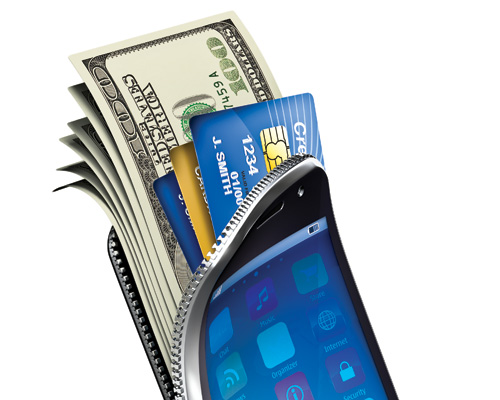 Source: Silicon Angle
Source: Silicon Angle- Near Field Communication (NFC): Contactless, almost instantaneous transfer of data between devices. NFC is often used in “Tap and Go” payment methods, such as tapping the smartphone to a device reader.
- Wireless Application Protocol (WAP): With WAP, the smartphone connects to the internet, then pays via an online payment system (such as Paypal or Google Wallet) or by entering credit card info through the merchant’s website. Alternatively, WAP can also defer the charge to the phone pill.
- Short Messaging Service (SMS) Payments: Considered a bit more “old-school”, SMS allows users to pay for goods and services via a text message sent from the phone. The cost of the item is then added to the user’s monthly phone bill.
- In-App Billing or Direct Mobile Billing: Most commonly used when purchasing an app from an online store or a game, this system charges the cost of the product to the monthly phone bill.
- QR Code Payments: CurrentC is one company in the U.S. experimenting with using QR codes to purchase items. Although QR codes are not as common in the U.S. it is much more popular in Europe and Asia. It will be interesting to see if QR codes will catch on with American audiences.
- Direct Carrier/Bank Cooperation: No credit card number or bank account information is needed. Instead, the mobile phone and phone carrier become the front-end interface for consumers to purchase goods and transfer money via a mobile phone number. This payment system is in its very early experimental stages.
- Audio Signal-Based Payment: This sounds like something from a sci-fi movie. This payment system uses acoustic feature of phones to support mobile payments and other applications that are not chip-based. The microphone on cell phones can pick up these audio signatures to enable electronic transactions. The advantage to this is that all phones are capable of picking up audio signals, whereas not every phone is NFC-equipped.
- Bitcoin: Bitcoin is an online payment system that was developed in 2009 that utilizes virtual, alternative currency with no transaction fees, with gives it a leg up from traditional credit cards. There are also no middle men (like banks) to take additional transaction fees. Consumers can purchase their merchandise anonymously. Bitcoin has yet to gain a lot of traction in with the mainstream audience, though small percentage of merchants accept it. Some people are purchasing bitcoins as an investment, hoping they will dramatically increase in value over time.

Jennifer Pan is a marketing coordinator at Logic Solutions. If you want to get her attention, try talking to her about d20s, (board) games, sci-fi and geeky references, or cute animal videos…or all of them at once. Just don’t bring up her uncanny ability to roll natural 1s.

